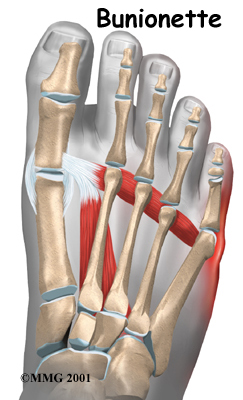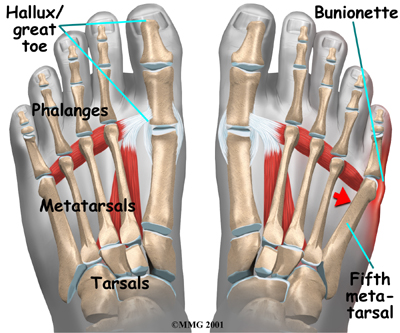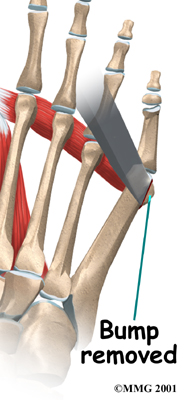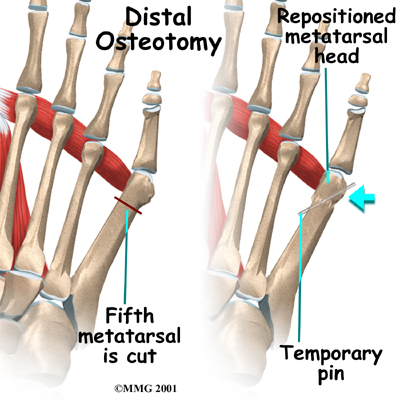Introduction
Physiotherapy in Redcliffe for Foot

Welcome to My Health Team's patient resource in Redcliffe about Tailor's Bunion.
A bunionette is similar to a bunion, but it develops on the outside of the foot. It is sometimes referred to as a tailor's bunion because tailors once sat cross-legged all day with the outside edge of their feet rubbing on the ground. This produced a pressure area and callus at the bottom of the fifth toe.
This guide will help you understand:
- where a bunionette develops
- why a bunionette causes problems
- what can be done to treat a bunionette
#testimonialslist|kind:all|display:slider|orderby:type|filter_utags_names:Foot therapy|limit:15|heading:Hear from some of our *Foot Therapy* patients#
Anatomy

Where does a bunionette develop?
A bunionette occurs over the area of the foot where the small toe connects to the foot. This area is called the metatarsophalangeal joint, or MTP joint. The metatarsals are the long bones of the foot. The phalanges are the small bones in each toe. The big toe has two phalanges, and the other toes have three phalanges each.
Related Document: My Health Team's Guide to Foot Anatomy
Causes
How does a bunionette develop?
Today a bunionette is most likely caused by an abnormal bump over the end of the fifth metatarsal (the metatarsal head) rubbing on shoes that are too narrow. Some people's feet widen as they grow older, until the foot splays. This can cause a bunion on one side of the foot and a bunionette on the other if they continue to wear shoes that are too narrow. The constant pressure produces a callus and a thickening of the tissues over the bump, leading to a painful knob on the outside of the foot.
Many problems that occur in the feet are the result of abnormal pressure or rubbing. One way of understanding what happens in the foot as a result of abnormal pressure is to view the foot simply. Essentially a foot is made up of hard bone covered by soft tissue that we then put a shoe on top of. Most of the symptoms that develop over time are because the skin and soft tissue are caught between the hard bone on the inside and the hard shoe on the outside.
Any prominence, or bump, in the bone will make the situation even worse over the bump. Skin responds to constant rubbing and pressure by forming a callus. The soft tissues underneath the skin respond to the constant pressure and rubbing by growing thicker. Both the thick callus and the thick soft tissues under it are irritated and painful. The answer to decreasing the pain is to remove the pressure. The pressure can be reduced from the outside by changing the pressure from the shoes. The pressure can be reduced from the inside by surgically removing any bony prominence.
Symptoms
What do bunionettes feel like?
The symptoms of a bunionette include pain and difficulty buying shoes that will not cause pain around the deformity. The swelling in the area causes a visible bump that some people find unsightly.
Diagnosis
How do health care providers identify a bunionette?
When you first visit My Health Team, our physiotherapist will examine your foot and speak with you about the history of your problem. Diagnosis of a bunionette is usually obvious and can be made during the history and physical examination.
Some patients may be referred to a doctor for further diagnosis. Once your diagnostic examination is complete, the physiotherapists at My Health Team have treatment options that will help speed your recovery, so that you can more quickly return to your active lifestyle.
Our Treatment
Non-surgical Rehabilitation
When you begin physiotherapy at My Health Team, treatment is initially directed at obtaining proper shoes that will accommodate the width of your forefoot. Our physiotherapist may recommend pads over the area of the bunionette to help relieve some of the pressure and reduce pain. These pads are usually available in drug and grocery stores. Our physiotherapist can also offer ideas of shoes that have a wide forefoot, or toe box. The added space in this part of the shoe keeps the metatarsals from getting squeezed inside the shoe.
These simple changes to your footwear may allow you to resume normal walking immediately, but we suggest that you cut back on more vigorous activities for several weeks to allow the inflammation and pain to subside.
During physiotherapy, your physiotherapist may also direct treatments to the painful area to help control pain and swelling. Examples include ultrasound, moist heat, and soft-tissue massage. Our therapy sessions sometimes include iontophoresis, which uses a mild electrical current to push anti-inflammatory medicine to the sore area. This treatment is especially helpful for patients who can't tolerate injections.
Post-surgical Rehabilitation
Patients are usually fitted with a post-op shoe after surgery. This shoe has a stiff, rigid sole that protects your toes by keeping the foot from bending. Any pins are usually removed after the bone begins to mend (usually three or four weeks). You will probably need crutches briefly after surgery, and your physiotherapist at My Health Team can instruct you in how to properly use your crutches to avoid putting too much weight on your foot.
You will probably wear a bandage or dressing for about a week following the procedure. The stitches are generally removed in 10 to 14 days. However, if your surgeon chose to use sutures that dissolve, you won't need to have the stitches taken out.
When you visit My Health Team after your surgery, our physiotherapist will develop a personalized rehabilitation program to help speed our recovery. When your recovery is well under way, regular visits to My Health Team will end. Although we will continue to be a resource, you will eventually be in charge of doing therapeutic exercises as part of an ongoing home program.
My Health Team provides services for physiotherapy in Redcliffe.
Physician Review
The diagnosis of a bunionette is usually obvious on physical examination. X-rays may help to see if the foot has splayed and will help decide what needs to be done if surgery is necessary later.
If you end up having surgery on your bunion, you will need additional X-rays during your post-operative follow-up visits, so that the surgeon can follow the healing of the bones and determine how much correction has been achieved.
Surgery
If all else fails, surgery may be recommended to reduce the deformity. Surgery usually involves removing the prominence of bone underneath the bunion to relieve pressure. Surgery may also be done to realign the fifth metatarsal if the foot has splayed.
Bunionette Removal
To remove the prominence, the surgeon makes a small incision in the skin over the bump. The bump is then removed with a small chisel, and the bone edges are smoothed. Once enough bone has been removed, the skin is closed with small stitches.

Distal Osteotomy
If your doctor decides that the angle of the metatarsal is too great, the fifth metatarsal bone may be cut and realigned. This is called an osteotomy. Once the surgeon has performed the osteotomy, the bones are realigned and held in position with metal pins. The metal pins remain in place while the bones heal.

Portions of this document copyright MMG, LLC.
 Get Immediate Access To Your Special Report And Top Tips From Our PTs!
Get Immediate Access To Your Special Report And Top Tips From Our PTs!


